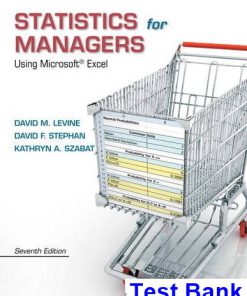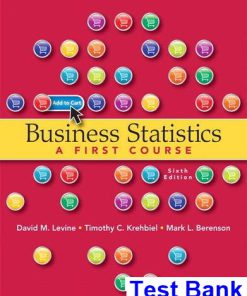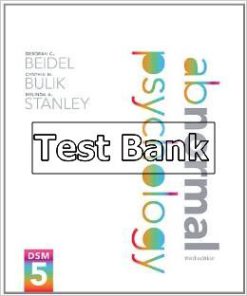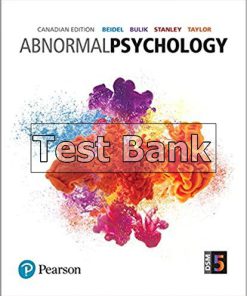Statistics for Managers using MS Excel 6th Edition Levine Test Bank
$26.50$50.00 (-47%)
Statistics for Managers using MS Excel 6th Edition Levine Test Bank.
You may also like
-
$26.50
$50.00
Statistics for Managers using MS Excel 6th Edition Levine Test Bank

Product details:
- ISBN-10 : 0137035195
- ISBN-13 : 978-0137035199
- Author: David M. Levine, Mark L. Berenson, Timothy C. Krehbiel, David F. Stephan
Analyze the data, see the business relevance. Reducing the emphasis on doing computations, this practical text thoroughly integrates Microsoft Excel as a tool for analysis and presents statistical concepts in the context of the functional areas of business. The sixth edition focuses on making statistics even more relevant to the business world and builds on the book’s hallmark feature of helping readers with the analysis of statistics.
Table contents:
Preface
xxi
Introduction 2(12)
Using Statistics Good Tunes & More 3(1)
Why Learn Statistics 4(1)
Statistics in Business 4(1)
Basic Vocabulary of Statistics 5(2)
How to Use This Book 7(7)
Using Statistics Good Tunes & More Revisited 7(1)
Summary 8(1)
Key Terms 8(1)
Chapter Review Problems 8(1)
End-of-Chapter Cases 9(1)
Learning with the Web Cases 9(1)
References 10(1)
Excel Guide 11(1)
Getting Started with Excel and the Excel Guides 11(1)
Checklist for Using Excel with This Book 12(1)
How to Prepare and Use Data 12(1)
Computing Conventions Used in This Book 13(1)
Organizing and Visualizing Data 14(70)
Using Statistics Choice is Yours, Part I 15(1)
Types of Variables 16(4)
Levels of Measurement and Measurement Scales 17(3)
Data Collection 20(1)
Organizing Data 21(1)
Organizing Categorical Data 21(4)
The Summary Table 21(1)
The Contingency Table 22(3)
Organizing Numerical Data 25(7)
The Ordered Array 25(1)
The Frequency Distribution 26(2)
The Relative Frequency Distribution and the Percentage Distribution for Numerical Variables 28(1)
The Cumulative Distribution 29(3)
Visualizing Data 32(1)
Visualizing Categorical Data 32(7)
The Bar Chart 32(2)
The Pie Chart 34(1)
The Pareto Chart 35(2)
The Side-by-Side Bar Chart 37(2)
Visualizing Numerical Data 39(9)
The Stem-and-Leaf Display 40(1)
The Histogram 41(1)
The Percentage Polygon 42(1)
The Cumulative Percentage Polygon (Ogive) 43(5)
Visualizing Two Numerical Variables 48(4)
The Scatter Plot 48(2)
The Time-Series Plot 50(2)
Using PivotTables to Explore Multidimensional Data 52(3)
Drill-down 54(1)
Misuses and Common Errors in Visualizing Data 55(29)
Using Statistics Choice is Yours, Part I Revisited 59(1)
Summary 59(1)
Key Equations 60(1)
Key Terms 60(1)
Chapter Review Problems 60(6)
Managing the Springville Herald 66(1)
Web Case 66(1)
References 67(1)
Excel Guide 68(1)
Types of Variables 68(1)
Data Collection 68(1)
Organizing Categorical Data 68(3)
Organizing Numerical Data 71(2)
Visualizing Categorical Data 73(3)
Visualizing Numerical Data 76(4)
Visualizing Two Numerical Variables 80(1)
Using PivotTables to Explore Multidimensional Data 81(3)
Numerical Descriptive Measures 84(48)
Using Statistics Choice is Yours, Part II 85(1)
Measures of Central Tendency 86(5)
The Mean 86(2)
The Median 88(1)
The Mode 89(1)
The Geometric Mean 90(1)
Variation and Shape 91(11)
The Range 91(1)
The Variance and the Standard Deviation 92(4)
The Coefficient of Variation 96(1)
Z Scores 96(2)
Shape 98(1)
Visual Explorations: Exploring Descriptive Statistics 99(3)
Exploring Numerical Data 102(7)
Quartiles 102(2)
The Interquartile Range 104(1)
The Five-Number Summary 105(1)
The Boxplot 106(3)
Numerical Descriptive Measures for a Population 109(5)
The Population Mean 110(1)
The Population Variance and Standard Deviation 110(1)
The Empirical Rule 111(1)
The Chebyshev Rule 112(2)
The Covariance and the Coefficient of Correlation 114(6)
The Covariance 114(2)
The Coefficient of Correlation 116(4)
Descriptive Statistics: Pitfalls and Ethical Issues 120(12)
Using Statistics Choice is Yours, Part II Revisited 121(1)
Summary 121(1)
Key Equations 122(1)
Key Terms 123(1)
Chapter Review Problems 123(4)
Managing the Springville Herald 127(1)
Web Case 127(1)
References 128(1)
Excel Guide 129(1)
Measures of Central Tendency 129(1)
Variation and Shape 129(1)
Exploring Numerical Data 130(1)
Numerical Descriptive Measures for a Population 130(1)
The Covariance and the Coefficient of Correlation 131(1)
Basic Probability 132(28)
Using Statistics M & R Electronics World 133(1)
Basic Probability Concepts 134(8)
Events and Samples Space 135(1)
Contingency Tables 136(1)
Simple Probability 136(1)
Joint Probability 137(1)
Marginal Probability 138(1)
General Addition Rule 138(4)
Conditional Probability 142(7)
Computing Conditional Probabilities 142(1)
Decision Trees 143(1)
Independence 144(1)
Multiplication Rules 145(1)
Marginal Probability Using the General Multiplication Rule 146(3)
Bayes’ Theorem 149(4)
Think About This: Divine Providence and Spam 152(1)
Ethical Issues and Probability 153(1)
Online Topic: Counting Rules 154(6)
Using Statistics M & R Electronics World Revisited 154(1)
Summary 155(1)
Key Equations 155(1)
Key Terms 155(1)
Chapter Review Problems 156(2)
Web Case 158(1)
References 158(1)
Excel Guide 159(1)
Basic Probability Concepts
Conditional Probability
Bayes’ Theorem
Discrete Probability Distributions
Using Statistics Saxon Home Improvement
The Probability Distribution for a Discrete Random Variable
Expected Value of a Discrete Random Variable
Variance and Standard Deviation of a Discrete Random Variable
Covariance and its Application in Finance
Covariance
Expected Value, Variance, and Standard Deviation of the Sum of Two Random Variables
Portfolio Expected Returns and Portfolio Risk
Binomial Distribution
Poisson Distribution
Hypergeometric Distribution
Using Statistics Saxon Home Improvement Revisited
Summary
Key Equations
Key Term
Chapter Review Problems
Managing the Springville Herald
Web Case
References
Excel Guide
The Probability Distribution for a Discrete Random Variable
Covariance and its Application in Finance
Binomial Distribution
Poisson Distribution
Hypergeometric Distribution
The Normal Distribution and Other Continuous Distributions
Using Statistics OurCampus!
Continuous Probability Distributions
The Normal Distribution
Visual Explorations: Exploring the Normal Distribution
Think About This: What is Normal?
Evaluating Normality
Comparing Data Characteristics to Theoretical Properties
Constructing the Normal Probability Plot
The Uniform Distribution
The Exponential Distribution
Online Topic: The Normal Approximation to the Binomial Distribution
Using Statistics OurCampus! Revisited
Summary
Key Equations
Key Terms
Chapter Review Problems
Managing the Springville Herald
Web Case
References
Excel Guide
Continuous Probability Distributions
The Normal Distribution
Evaluating Normality
The Uniform Distribution
The Exponential Distribution
Sampling and Sampling Distributions
Using Statistics Oxford Cereals
Types of Sampling Methods
Simple Random Samples
Systematic Samples
Stratified Samples
Cluster Samples
Evaluating Survey Worthiness
Survey Errors
Ethical Issues
Think About This: Probability Sampling Versus Web-Based Surveys
Sampling Distributions
232(1)
Sampling Distribution of the Mean
232(8)
The Unbiased Property of the Sample Mean
232(2)
Standard Error of the Mean
234(1)
Sampling from Normally Distributed Populations
235(3)
Sampling from Non-Normally Distributed Populations—The Central Limit Theorem
238(1)
Visual Explorations: Exploring Sampling Distributions
239(1)
Sampling Distribution of the Proportion
240(3)
Online Topic: Sampling from Finite Populations
243(7)
Using Statistics Oxford Cereals Revisited
243(1)
Summary
244(1)
Key Equations
244(1)
Key Terms
244(1)
Chapter Review Problems
245(2)
Managing the Springville Herald
247(1)
Web Case
247(1)
References
247(1)
Excel Guide
248(1)
Types of Sampling Methods
248(1)
Evaluating Survey Worthiness
248(1)
Sampling Distributions
248(1)
Sampling Distribution of the Mean
248(1)
Sampling Distribution of the Proportion
249(1)
Confidence Interval Estimation
250(46)
Using Statistics Saxon Home Improvement
251(1)
Confidence Interval Estimation for the Mean (& Known)
252(6)
Can You Ever Know the Population Standard Deviation?
257(1)
Confidence Interval Estimation for the Mean (& Unknown)
258(8)
Student’s t Distribution
258(1)
Properties of the t Distribution
258(2)
The Concept of Degrees of Freedom
260(1)
The Confidence Interval Statement
260(6)
Confidence Interval Estimation for the Proportion
266(3)
Determining Sample Size
269(6)
Sample Size Determination for the Mean
269(2)
Sample Size Determination for the Proportion
271(4)
Applications of Confidence Interval Estimation in Auditing
275(7)
Estimating the Population Total Amount
275(2)
Difference Estimation
277(3)
One-Sided Confidence Interval Estimation of the Rate of Noncompliance with Internal Controls
280(2)
Confidence Interval Estimation and Ethical Issues
282(1)
Online Topic: Estimation and Sample Size Determination for Finite Populations
282(14)
Using Statistics Saxon Home Improvement Revisited
283(1)
Summary
283(1)
Key Equations
284(1)
Key Terms
284(1)
Chapter Review Problems
285(4)
Managing the Springville Herald
289(1)
Web Case
290(1)
References
290(2)
Excel Guide
292(1)
Confidence Interval Estimation for the Mean (& Known)
292(1)
Confidence Interval Estimation for the Mean (& Unknown)
292(1)
Confidence Interval Estimation for the Proportion
293(1)
Determining Sample Size
293(1)
Applications of Confidence Interval Estimation in Auditing
294(2)
Fundamentals of Hypothesis Testing: One-Sample Tests
296(38)
Using Statistics Oxford Cereals, Part II
297(1)
Fundamentals of Hypothesis-Testing Methodology
298(12)
The Null and Alternative Hypotheses
298(1)
The Critical Value of the Test Statistic
299(1)
Regions of Rejection and Nonrejection
300(1)
Risks in Decision Making Using Hypothesis Testing
300(3)
Hypothesis Testing Using the Critical Value Approach
303(2)
Hypothesis Testing Using The p-Value Approach
305(3)
A Connection Between Confidence Interval Estimation and Hypothesis Testing
308(1)
Can You Ever Know the Population Standard Deviation?
308(2)
t Test of Hypothesis for the Mean (& Unknown)
310(6)
The Critical Value Approach
310(2)
The p-Value Approach
312(1)
Checking the Normality Assumption
312(4)
One-Tail Tests
316(5)
The Critical Value Approach
316(2)
The p-Value Approach
318(3)
Z Test of Hypothesis for the Proportion
321(4)
The Critical Value Approach
322(1)
The p-Value Approach
323(2)
Potential Hypothesis-Testing Pitfalls and Ethical Issues
325(1)
Online Topic: The Power of a Test
326(8)
Using Statistics Oxford Cereals, Part II Revisited
326(1)
Summary
327(1)
Key Equations
327(1)
Key Terms
327(1)
Chapter Review Problems
327(3)
Managing the Springville Herald
330(1)
Web Case
330(1)
References
330(1)
Excel Guide
331(1)
Fundamentals of Hypothesis-Testing Methodology
331(1)
t Test of Hypothesis for the Mean (& Unknown)
331(1)
One-Tail Tests
332(1)
Z Test of Hypothesis for the Proportion
333(1)
Two-Sample Tests
334(46)
Using Statistics BLK Foods
335(1)
Comparing the Means of Two Independent Populations
336(9)
Pooled-Variance t Test for the Difference Between Two Means
336(5)
Confidence Interval Estimate for the Difference Between Two Means
341(1)
t Test for the Difference Between Two Means Assuming Unequal Variances
342(1)
Think About This: “This Call May Be Monitored…”
343(2)
Comparing the Means of Two Related Populations
345(7)
Paired t Test
346(6)
Confidence Interval Estimate for the Mean Difference
352(9)
Comparing the Proportions of Two Independent Populations
354(1)
Z Test for the Difference Between Two Proportions
354(4)
Confidence Interval Estimate for the Difference Between Two Proportions
358(3)
F Test for the Ratio of Two Variances
361(19)
Using Statistics BLK Foods Revisited
366(1)
Summary
366(1)
Key Equations
367(1)
Key Terms
368(1)
Chapter Review Problems
368(4)
Managing the Springville Herald
372(1)
Web Case
372(1)
References
373(1)
Excel Guide
374(1)
Organizing Two-Sample Data
374(1)
Comparing the Means of Two Independent Populations
374(2)
Comparing the Means of Two Related Populations
376(1)
Comparing the Proportions of Two Independent Populations
377(1)
F Test for the Ratio of Two Variances
378(2)
Analysis of Variance
380(42)
Using Statistics Perfect Parachutes
381(1)
The Completely Randomized Design: One-Way Analysis of Variance
382(14)
One-Way ANOVA F Test for Differences Among More Than Two Means
382(6)
Multiple Comparisons: The Tukey-Kramer Procedure
388(2)
Online Topic: The Analysis of Means (ANOM)
390(1)
ANOVA Assumptions
390(1)
Levene Test for Homogeneity of Variance
391(5)
The Factorial Design: Two-Way Analysis of Variance
396(12)
Testing for Factor and Interaction Effects
396(5)
Multiple Comparisons: The Tukey Procedure
401(1)
Visualizing Interaction Effects: The Cell Means Plot
402(1)
Interpreting Interaction Effects
403(5)
Online Topic: The Randomized Block Design
408(14)
Using Statistics Perfect Parachutes Revisited
408(1)
Summary
408(1)
Key Equations
409(1)
Key Terms
410(1)
Chapter Review Problems
410(4)
Managing the Springville Herald
414(1)
Web Case
415(1)
References
415(1)
Excel Guide
416(1)
Organizing Multiple-Sample Data
416(1)
The Completely Randomized Design: One-Way Analysis of Variance
416(3)
The Factorial Design: Two-Way Analysis of Variance
419(3)
Chi-Square Tests and Nonparametric Tests
422(48)
Using Statistics T.C. Resort Properties
423(1)
Chi-Square Test for the Difference Between Two Proportions
424(7)
Chi-Square Test for Difference Among More Than Two Proportions
431(7)
The Marascuilo Procedure
435(1)
Online Topic: The Analysis of Proportions (ANOP)
436(2)
Chi-Square Test of Independence
438(5)
McNemar Test for the Difference Between Two Proportions (Related Samples)
443(4)
Wilcoxon Rank Sum Test: Nonparametric Analysis for Two Independent Populations
447(6)
Kruskal-Wallis Rank Test: Nonparametric Analysis for the One-Way ANOVA
453(5)
Chi-Square Test for the Variance or Standard Deviation
458(12)
Using Statistics T.C. Resort Properties Revisited
458(1)
Summary
458(1)
Key Equations
459(1)
Key Terms
460(1)
Chapter Review Problems
460(4)
Managing the Springville Herald
464(1)
Web Case
465(1)
References
465(1)
Excel Guide
466(1)
Chi-Square Test for the Difference Between Two Proportions
466(1)
Chi-Square Test for the Differences Among More Than Two Proportions
466(1)
Chi-Square Test of Independence
467(1)
McNemar Test for the Difference Between Two Proportions (Related Samples)
467(1)
Wilcoxon Rank Sum Test: Nonparametric Analysis for Two Independent Populations
468(1)
Kruskal-Wallis Rank Test: Nonparametric Analysis for the One-Way ANOVA
469(1)
Simple Linear Regression
470(56)
Using Statistics Sunflowers Apparel
471(1)
Types of Regression Models
472(2)
Determining the Simple Linear Regression Equation
474(8)
The Least-Squares Method
475(2)
Predictions in Regression Analysis: Interpolation Versus Extrapolation
477(1)
Computing the Y Intercept, b0, and the Slope, b1
478(2)
Visual Explorations: Exploring Simple Linear Regression Coefficients
480(2)
Measures of Variation
482(6)
Computing the Sum of Squares
483(1)
The Coefficient of Determination
484(2)
Standard Error of the Estimate
486(2)
Assumptions
488(1)
Residual Analysis
488(4)
Evaluating the Assumptions
488(4)
Measuring Autocorrelation: The Durbin-Watson Statistic
492(5)
Residual Plots to Detect Autocorrelation
493(1)
The Durbin-Watson Statistic
494(3)
Inferences About the Slope and Correlation Coefficient
497(7)
t Test for the Slope
497(1)
F Test for the Slope
498(2)
Confidence Interval Estimate for the Slope
500(1)
t Test for the Correlation Coefficient
500(4)
Estimation of Mean Values and Prediction of Individual Values
504(4)
The Confidence Interval Estimate
504(1)
The Prediction Interval
505(3)
Pitfalls in Regression
508(18)
Think About This: America’s Top Models
511(1)
Using Statistics Sunflowers Apparel Revisited
511(1)
Summary
512(1)
Key Equations
513(1)
Key Terms
514(1)
Chapter Review Problems
514(5)
Managing the Springville Herald
519(1)
Web Case
520(1)
References
520(1)
Excel Guide
521(1)
Types of Regression Models
521(1)
Determining the Simple Linear Regression Equation
521(2)
Measures of Variation
523(1)
Assumptions
523(1)
Residual Analysis
523(1)
Measuring Autocorrelation: The Durbin-Watson Statistic
524(1)
Inferences About the Slope and Correlation Coefficient
524(1)
Estimation of Mean Values and Prediction of Individual Values
524(2)
Introduction to Multiple Regression
526(44)
Using Statistics OmniFoods
527(1)
Developing a Multiple Regression Model
528(5)
Interpreting the Regression Coefficients
528(2)
Predicting the Dependent Variable Y
530(3)
r2, Adjusted r2, and the Overall F Test
533(4)
Coefficient of Multiple Determination
533(1)
Adjusted r2
534(1)
Test for the Significance of the Overall Multiple Regression Model
535(2)
Residual Analysis for the Multiple Regression Model
537(2)
Inferences Concerning the Population Regression Coefficients
539(4)
Tests of Hypothesis
539(2)
Confidence Interval Estimation
541(2)
Testing Portions of the Multiple Regression Model
543(5)
Coefficients of Partial Determination
546(2)
Using Dummy Variables and Interaction Terms in Regression Models
548(22)
Interactions
551(7)
Using Statistics OmniFoods Revisited
558(1)
Summary
558(2)
Key Equations
560(1)
Key Terms
560(1)
Chapter Review Problems
561(3)
Managing the Springville Herald
564(1)
Web Case
564(1)
References
565(1)
Excel Guide
566(1)
Developing a Multiple Regression Model
566(1)
r2, Adjusted r2, and the Overall F Test
567(1)
Residual Analysis for the Multiple Regression Model
567(1)
Inference Concerning the Population Regression Coefficients
568(1)
Testing Portions of the Multiple Regression Model
569(1)
Using Dummy Variables and Interaction Terms in Regression Models
569(1)
Multiple Regression Model Building
570(34)
Using Statistics WTT-TV
571(1)
The Quadratic Regression Model
572(8)
Finding the Regression Coefficients and Predicting Y
572(3)
Testing for the Significance of the Quadratic Model
575(1)
Testing the Quadratic Effect
575(2)
The Coefficient of Multiple Determination
577(3)
Using Transformations in Regression Models
580(4)
The Square-Root Transformation
580(1)
The Log Transformation
581(3)
Collinearity
584(2)
Model Building
586(10)
The Stepwise Regression Approach to Model Building
588(1)
The Best-Subsets Approach to Model Building
589(5)
Model Validation
594(2)
Pitfalls in Multiple Regression and Ethical Issues
596(8)
Pitfalls in Multiple Regression
596(1)
Ethical Issues
596(1)
Using Statistics WTT-TV Revisited
596(1)
Summary
597(1)
Key Equations
598(1)
Key Terms
598(1)
Chapter Review Problems
598(2)
The Mountain States Potato Company
600(1)
Web Case
601(1)
References
601(1)
Excel Guide
602(1)
The Quadratic Regression Model
602(1)
Using Transformations in Regression Models
602(1)
Collinearity
602(1)
Model Building
602(2)
Time-Series Forecasting
604(50)
Using Statistics The Principled
605(1)
The Importance of Business Forecasting
606(1)
Component Factors of Time-Series Models
606(1)
Smoothing an Annual Time Series
607(6)
Moving Averages
608(2)
Exponential Smoothing
610(3)
Least-Squares Trend Fitting and Forecasting
613(10)
The Linear Trend Model
613(2)
The Quadratic Trend Model
615(1)
The Exponential Trend Model
616(2)
Model Selection Using First, Second, and Percentage Differences
618(5)
Autoregressive Modeling for Trend Fitting and Forecasting
623(9)
Choosing an Appropriate Forecasting Model
632(4)
Performing a Residual Analysis
632(1)
Measuring the Magnitude of the Residuals Through Squared or Absolute Differences
633(1)
Using the Principle of Parsimony
634(1)
A Comparison of Four Forecasting Methods
634(2)
Time-Series Forecasting of Seasonal Data
636(7)
Least-Squares Forecasting with Monthly or Quarterly Data
637(6)
Index Numbers
643(11)
Think About This: Let the Model User Beware
643(1)
Using Statistics The Principled Revisited
643(1)
Summary
644(1)
Key Equations
644(1)
Key Terms
645(1)
Chapter Review Problems
646(1)
Managing the Springville Herald
647(1)
Web Case
648(1)
References
648(1)
Excel Guide
649(1)
The Importance of Business Forecasting
649(1)
Component Factors of Time-Series Models
649(1)
Smoothing an Annual Time Series
649(1)
Least-Squares Trend Fitting and Forecasting
650(2)
Autoregressive Modeling for Trend Fitting and Forecasting
652(1)
Choosing an Appropriate Forecasting Model
652(1)
Time-Series Forecasting of Seasonal Data
653(1)
Statistical Applications in Quality Management
654(46)
Using Statistics Beachcomber Hotel
655(1)
The Theory of Control Charts
656(2)
Control Chart for the Proportion: The p Chart
658(6)
The Red Bead Experiment: Understanding Process Variability
664(2)
Control Chart for an Area of Opportunity: The c Chart
666(4)
Control Chart for the Range and the Mean
670(5)
The R Chart
670(2)
The X Chart
672(3)
Process Capability
675(5)
Customer Satisfaction and Specification Limits
675(2)
Capability Indices
677(1)
CPL, CPU, and Cpk
678(2)
Total Quality Management
680(2)
Six Sigma
682(18)
The DMAIC Model
682(1)
Roles in a Six Sigma Organization
683(1)
Using Statistics Beachcomber Hotel Revisited
684(1)
Summary
685(1)
Key Equations
685(1)
Key Terms
686(1)
Chapter Review Problems
686(3)
The Harnswell Sewing Machine Company Case
689(2)
Managing the Springville Herald
691(1)
References
692(2)
Excel Guide
694(1)
The Theory of Control Charts
694(1)
Control Chart for the Proportion: The p Chart
694(2)
The Red Bead Experiment: Understanding Process Variability
696(1)
Control Chart for an Area of Opportunity: The c Chart
696(1)
Control Charts for the Range and the Mean
697(2)
Process Capability
699(1)
Total Quality Management
699(1)
Six Sigma
699(1)
Data Analysis Overview
700(9)
Using Statistics in Your Life
701(2)
Analyzing Numerical Variables
703(2)
How to Describe the Characteristics of a Numerical Variable
704(1)
How to Draw Conclusions About the Population Mean or Standard Deviation
704(1)
How to Determine Whether the Mean or Standard Deviation Differs Depending on the Group
704(1)
How to Determine Which Factors Affect the Value of a Variable
705(1)
How to Predict the Value of a Variable Based on the Value of Other Variables
705(1)
How to Determine Whether the Values of a Variable Are Stable over Time
705(1)
Analyzing Categorical Variables
705(4)
How to Describe the Proportion of Items of Interest in Each Category
705(1)
How to Draw Conclusions About the Proportion of Items of Interest
706(1)
How to Determine Whether the Proportion of Items of Interest Differs Depending on the Group
706(1)
How to Predict the Proportion of Items of Interest Based on the Value of Other Variables
706(1)
How to Determine Whether the Proportion of Items of Interest is Stable over Time
706(1)
Using Statistics in Your Life Revisited
706(1)
Chapter Review Problems
Online
Chapter: 19 Decision Making
Using Statistics Reliable Fund
Payoff Tables and Decision Trees
Criteria for Decision Making
Maximax Payoff
Maximin Payoff
Expected Monetary Value
Expected Opportunity Loss
Return-to-Risk Ratio
Decision Making with Sample Information
Utility
Think About This: Risky Business
Using Statistics Reliable Fund Revisited
Summary
Key Equations
Key Terms
Chapter Review Problems
Web Case
References
Excel Guide for
Chapter 20
Payoff Tables and Decision Trees
Criteria for Decision Making
Appendices
Basic Math Concepts and Symbols
Rules for Arithmetic Operations
Rules for Algebra: Exponents and Square Roots
Rules for Logarithms
Summation Notation
Statistical Symbols
Greek Alphabet
Basic Excel Knowledge
Purpose of This Appendix
Fundamental Computing Operations
Worksheets and Workbooks
Worksheet Entries
Cell References
Entering Formulas Into Worksheets
Absolute and Relative Cell References
Useful Excel Commands
Opening and Saving Workbooks
Creating New Workbooks and Worksheets
Printing Worksheets
Verifying Formulas and Worksheets
Enhancing Workbook Presentation
Useful Keyboard Shortcuts
Chart Formatting (Excel 2007)
Chart Formatting (Excel 2003)
Creating Histograms for Discrete Probability Distributions (Excel 2007)
Creating Histograms for Discrete Probability Distributions (Excel 2003)
Formula “Tricks” of the ANOVA Workbooks
Pasting With Paste Special
Technical Tips
Visiting the Companion Website for This Book
Downloading the Files for This Book
Checking for and Applying Excel Updates
Concise Instructions for Installing PHStat2
Configuring Excel for PHStat2 Usage
Checking for the Presence of the Analysis ToolPak
Using the Visual Explorations Add-in Workbook
Accessing the Online Topic Files and Case Files Online
Tables
Downloadable Files for this Book
Downloadable Excel Data Workbooks
Downloadable Excel Guide Workbooks
Downloadable Online Topics
Other Downloadable Files
PHStat2 and Excel FAQs
PHStat2 FAQs
Microsoft Excel FAQs
FAQs for New Microsoft Excel 2007 Users
FAQs for New Microsoft Excel 2010 Users
Self-Test Solutions and Answers to Selected Even-Numbered Problems
Index
People also search:
Statistics for managers using ms excel 6th edition
Statistics for managers using microsoft excel
Business statistics excel formulas
Business statistics excel
Statistics for managers using microsoft excel 8th edition chegg












